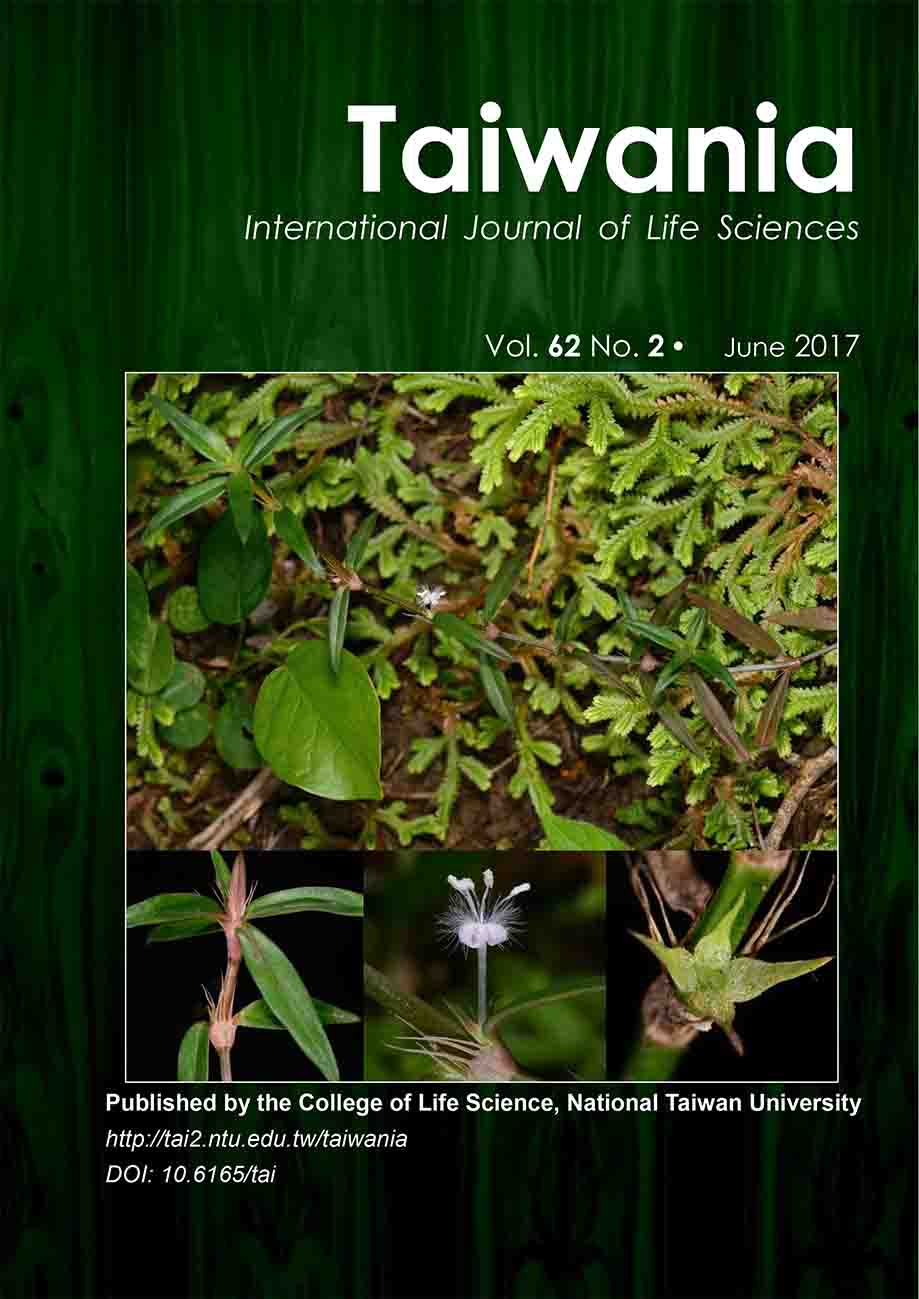Research Paper
Seed germination and predation of the tropical monocarpic palm tree Corypha umbraculifera
R.P.V.G. Subhashi W. Rajapakshe, K.M.G. Gehan Jayasuriya, Sanath Rajapakse and D.H.P. Peramunugama
Published on: 07 April 2017
Page: 129 - 138
DOI: 10.6165/tai.2017.62.129
Abstract
Corypha umbraculifera L., the long lived monocarpic palm belonging to Arecaceae, is rare in the wild and is a possible candidate, which can be developed as an economic plant in Asia. However, little information is available about propagation of this species from seeds. Thus, we aimed to investigate the basic seed biology of this species and to facilitate its propagation and conservation. Effects of light and temperature on seed germination were studied. Morphology of seed germination and embryo: seed ratio were recorded. Seed predation percentages, initial moisture content and nutrient content were determined and optimum storage conditions identified. The highest germination percentage was in light/dark at 25 ˚C. In two trials, of 38.66 and 31.66 % of the seeds were predated. Total energy value of seeds was higher than that of Cocos nucifera, a common known polycarpic palm. Seeds of C. umbraculifera have morphophysiological dormancy as evidence by embryo growth prior to radicle emergence and the relatively long time (42-49 days) taken for completion of germination. Low predation percentage and slow germination rate indicate that the predator satiation hypothesis is not sufficient to describe the evolution and existence of monocarpy in C. umbraculifera. Decreased viability during dry storage at ambient room conditions and a moisture content of 16 ± 3 % indicate that seeds have intermediate storage behaviour. Storage in open polythene bags at 8 ˚C is suggested as the best storage condition for C. umbraculifera seeds.
Keyword: Conservation, Corypha umbraculifera, Morphophysiological dormancy, Seed predation, Seed storage, Semelparity
Literature Cited
Baskin, C.C. and J.M. Baskin. 1998. Seeds: ecology, biogeography, and evolution of dormancy and germination. Academic Press, San Diego, California, USA.
Baskin, C.C. and J.M. Baskin. 2004. A classification system for seed dormancy. Seed Sci. Res. 14(1): 1?16.
DOI: 10.1079/SSR2003150View Article
Google Scholar
Baskin, C.C. and J.M. Baskin. 2007. A revision of Martin
DOI: 10.1017/S0960258507383189View Article
Google Scholar
Baskin, C.C. and J.M. Baskin. 2014. Seeds: ecology, biogeography, and evolution of dormancy and germination, 2nd ed. San Diego, CA, USA: Academic/Elsevier.
Berjak, P. and N.W. Pammenter. 1997. Progress in the understanding and manipulation of desiccation-sensitive (recalcitrant) seeds. In: Ellis, R. H., M. Black, A. J. Murdoch, and T. D. Hong, (eds.), Basic and applied aspects of seed biology, 689?703. Kluwer, Dordrecht, Netherlands.
DOI: 10.1007/978-94-011-5716-2_76View Article
Google Scholar
Bligh, E.G., and W.J. Dyer. 1959. A rapid method of total lipid extraction and purification. Can J Biochem Physiol 37(8): 911?917.
DOI: 10.1139/o59-099View Article
Google Scholar
Brown, R.F. and D.G. Mayer. 1988a. Representing cumulative germination. 1. A critical analysis of single-value germination indices. Ann. Bot. 61: 117?125.
DOI: 10.1093/oxfordjournals.aob.a087534View Article
Google Scholar
Chin, H.F. 1994. Storage of recalcitrant seeds. In A.S. Basra (ed.). Seed Quality, Basic Mechanisms and Agricultural Implications. Haworth Press Inc., Binghamton, NY, USA. 209?222.
Dassanayake, M.D. ed. (1980
Dickie, J.B., M.J. Black and I.M. Linington. 1992. Experimental investigations into the feasibility of ex situ preservation of palm seeds: an alternative strategy for biological conservation of this economically important plant family. Anim Biodivers Conserv. 1(2): 112?119.
DOI: 10.1007/BF00731038View Article
Google Scholar
Ellis, R.H., T.D. Hong, and E.H. Roberts. 1990. An intermediate category of seed storage behaviour? I. Coffee. J. Exp. Bot. 41(9): 1167?1174.
DOI: 10.1093/jxb/41.9.1167View Article
Google Scholar
Esenowo, G. and A.C. Adebona. 1990. Effect of high temperature pretreatment on the germination of Corypha umbraculifera (L.) seeds. Nigerian J. Bot. 3: 85?91.
Fisher, J. B., R. W. Saunders, and N. Edmonson. 1987. The flowering and fruiting of Corypha umbraculifera in Miami, Florida. Principes. 31: 68?77.
Gadgil, M. and S.N. Prasad. 1984. Ecological determinants of life history evolution of two Indian bamboo species. Biotropica. 16(3): 161?172.
DOI: 10.2307/2388050View Article
Google Scholar
Gadgil, M., and M.S. Chandran. 1988. On the history of Uttara Kannada forests. Changing tropical forests. In: Dargavel, J., K. Dixon and N. Semple (eds.), Changing tropical forests, Australian National University, Canberra, 47?58.
International Seed Testing Association (ISTA). 2012. International Rules for Seed Testing. ISTA, Zu richstrasse, Bassersdrof, Switzerland.
Janzen, D.H. 1976. Why bamboos wait so long to flower. Ann. Rev. Ecol. Evol. Syst. 7(1): 347?391.
DOI: 10.1146/annurev.es.07.110176.002023View Article
Google Scholar
Johnson, D.V. 1998. Corypha umbraculifera. The IUCN Red List of Threatened Species 1998: e.T38494A10118423.
Johnson, D.V. 1998. Non Wood forest Products 10: Tropical Palms. Food and Agriculture Organization of the United Nations, Vialedelle Terme di Caracalla, 00100 Rome, Italy.
Khondker, M., M.D.A. Hassan, M.D.A. Alfasane and U.F. Shahjadee. 2010. Flowering and fruiting characteristics and biochemical composition of an endangered palm species (Corypha taliera Roxb.). Bangladesh J Plant Taxon 17(1):76?86.
DOI: 10.3329/bjpt.v17i1.5393View Article
Google Scholar
Khoshbakht, K. and K. Hammer. 2007. Threatened and rare ornamental plants. JARTS 108: 19?39.
King, M.W. and E.H. Roberts. 1980. Maintenance of recalcitrant seeds in storage. In: H.F. Chin and E.H. Roberts (eds.), Recalcitrant crop seeds. Tropical Press, Kuala Lumpur, Malaysia. Pp. 53?89.
Koebernik, J. 1971. Germination of palm seed. International Palm Society Journal. 15: 134?137.
Layne, E. 1957. Spectrophotometric and turbidimetric methods for measuring proteins. Meth. Enzymol. 3: 447?455.
DOI: 10.1016/S0076-6879(57)03413-8View Article
Google Scholar
Naiola, B.P. and dan N. Nurhidayaf. 2009. Biology of Gewang (Corypha utan Lamarck) seeds: embryo content diversity, chemical content and the roles of microbes in seed germination. Berita. Biologi 9: 773?781.
Paulsen, T.R., L. Colville, I. Kranner, M.I. Daws, G. Hogstedt, V. Vandvik and K. Thompson. 2013. Physical dormancy in seeds: a game of hide and seek? New Phytol 198(2): 496
DOI: 10.1111/nph.12191View Article
Google Scholar
Roberts, E.H. 1973. Predicting the storage life of seeds. Seed Sci Technol. 1: 499?514.
Sautu, A. E., J.M. Baskin, C.C. Baskin, J. Deago and R. Condit. 2007. Classification and ecological relationships of seed dormancy in a seasonal moist tropical forest, Panama, Central America. Seed Sci. Res. 17(2): 127?140.
DOI: 10.1017/S0960258507708127View Article
Google Scholar
Schaffer, W. M. and M. L. Rosenzweig. 1977. Selection for optimal life histories. II: Multiple equilibria and the evolution of alternative reproductive strategies. Ecology. 58(1): 60?72.
DOI: 10.2307/1935108View Article
Google Scholar
Schimpf, D.J., S.D. Flint and I.G. Palmblad. 1977. Representation of germination curves with the logistic function. Ann. Bot. 41: 1357?1360.
DOI: 10.1093/oxfordjournals.aob.a085423View Article
Google Scholar
Snell, F.D. and C.T. Snell. 1970. New books-Colorimetric methods of analysis including photometric methods, vol. IVAA. Anal. Chim.. 42(14): 79A?79A.
DOI: 10.1021/ac50160a016View Article
Google Scholar
Sowa S. and E.E. Roos. 1991. Anesthetic storage of recalcitrant seed: nitrous oxide prolongs longevity of Lychee and Longan. HortScience 26: 597?599.
Stewart, J. 1992. Use of Atwater factors in USDA
Tomlinson, P.B. 2006. The uniqueness of palms. Bot. J. Linn. Soc. 151(1): 5?14.
DOI: 10.1111/j.1095-8339.2006.00520.xView Article
Google Scholar
Torres, M. and G. Frutos. 1989. Analysis of germination curves of aged fennel seeds by mathematical models. Environ. Exp. Bot. 29: 409
DOI: 10.1016/0098-8472(89)90016-6View Article
Google Scholar
USDA. 2008. National Nutrient Database for Standard Reference, Release 28. US Department of Agriculture, Agricultural Research Service, USDA Nutrient Data Laboratory.
Vander Wall, S.B. 1998. Foraging success of granivorous rodents: effects of variation in seed and soil water on olfaction. Ecology 79(1): 233
DOI: 10.1890/0012-9658(1998)079[0233:FSOGRE]2.0.CO;2View Article
Google Scholar
Viji, V., P. Ratheesh Chandra, S. Nabeesa and T.P. Jos. 2013. Influence of desiccation and associated metabolic changes during seed germination in Corypha umbraculifera Linn. Journal of Stress Physiology and. Biochemistry. 9: 37?43.
Viji, V., P. Ratheesh Chandra, S. Nabeesa and T.P. Jos. 2015. Germination associated morphological and anatomical changes in Corypha umbraculifera L. seeds. Phytomorphology 65: 11?17.
Young, T.P. 1990. Evolution of semelparity in Mount Kenya lobelias. Evol. Ecol. 4(2): 157-171.
DOI: 10.1007/BF02270913View Article
Google Scholar
Young, T.P. and C.K. Augspurger. 1991. Ecology and evolution of long-lived semelparous plants. Trends in Ecology & Evolution. 6(9): 285?289.
DOI: 10.1016/0169-5347(91)90006-JView Article
Google Scholar
Zhao, L., Y. Chen and D.W. Schaffner. 2001. Comparison of logistic regression and linear regression modeling percentage data. Appl Environ Microbiol 67(5): 2129?2135.
DOI: 10.1128/AEM.67.5.2129-2135.2001View Article
Google Scholar


